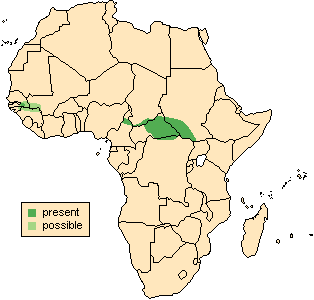![]() Return
to Artiodactyla
Return
to Artiodactyla
Classification
|
 Taurotragus
derbianus
Taurotragus
derbianus
Giant eland, Derby eland
![]()
Taxonomy
 |
 |
 |
Click on the pictures above for a larger view of the
photographs
|
||
General Characteristics
Body Length: 220-290 cm / 7.3-9.6 ft.
Shoulder Height: 150-175 cm / 5-5.8 ft.
Tail Length: 90 cm / 3 ft.
Weight: 440-900 kg / 970-2,000 lb.The smooth coat is reddish-brown to chestnut in colour, with several, well-defined vertical white stripes on the torso. A short-haired black spinal crest extends down the neck to the middle of the back, and is especially prominent on the shoulders. The slender legs are slightly lighter on their inner surfaces, with black and white markings just above the hooves. There are large black spots on the upper forelegs. The bridge of the nose is charcoal black in colour, and there is an thin, indistinct tan-coloured chevron between the eyes. The lips are white, along with several dots along the jaw-line. A pendulous dewlap, larger in males then females, originates from between the jowls and hangs to the upper chest, with a fringe of hair on its edge. An amorphous band of black almost completely encircles the lower neck, extending onto the dewlap. The tail is long, and ends with a dark tuft of hair. Both sexes have tightly spiralled horns, which are relatively straight. In males they form a wide "V" and can grow to 120 cm / 4 feet in length.
Ontogeny and Reproduction
Gestation Period: 9 months.
Young per Birth: 1
Weaning: After 6 months.
Sexual Maturity: Females at 15-36 months, males at 4-5 years.
Life span: Up to 25 years.
Ecology and Behavior
Primarily nocturnal, giant elands are highly nomadic, with large home ranges and seasonal migration patterns. During the day, herds often rest in sheltered areas. A gregarious species, giant eland herds do not disband in the wet season, but remain together, suggesting that social, rather than ecological factors are responsible for herding. There is no evidence of territoriality, and males rarely display aggressive tendencies, even during the breeding season. Giant eland are alert and wary, making them difficult to approach and observe. They can be quite fast, running over 70 kmph / 42 mph and, despite their size, are exceptional jumpers, easily clearing heights of 1.5 m / 5 feet.Family group: Herds containing up to 60 animals of both sexes have been reported, though groups of 15 to 25 are more usual. Males are often solitary.
Diet: Leaves, branches, and grasses. They drink regularly.
Main Predators: Lion, spotted hyena.
Distribution
Broad-leafed savannas and glades in two isolated pockets in central and western Africa.

Range Map (Redrawn from IEA, 1998)
Conservation Status
The giant eland is considered a low risk, near threatened species by the IUCN (1996). T. d. gigas is classified as a low risk, near threatened subspecies, while T. d. derbianus is classified as endangered.
Remarks
Despite the name "giant", only the Derby eland's much larger, diverging horns make it a giant over the common eland. Tauros (Greek) a bull; tragos (Greek) a he-goat. -anus (Latin) suffix meaning belonging to. The Thirteenth Earl of Derby (1775-1851) was formerly the Hon. E. S. Stanley, President of the Zoological Society of London in 1831.
Literature Cited
Happold, D. C. D. 1987. The Mammals of Nigeria. Oxford: Clarendon Press.IEA (Institute of Applied Ecology) 1998. Taurotragus derbianus. In African Mammals Databank - A Databank for the Conservation and Management of the African Mammals Vol 1 and 2. Bruxelles: European Commission Directorate. Available online at http://gorilla.bio.uniroma1.it/amd/amd333b.html
Kingdon, J. 1997. The Kingdon Field Guide to African Mammals. Academic Press, London and New York: NaturalWorld.
Nowak, R. M. [editor]. 1991. Walker's Mammals of the World (Fifth Edition). Baltimore: The Johns Hopkins University Press.
Wilson, D. E., and D. M. Reeder [editors]. 1993. Mammal Species of the World (Second Edition). Washington: Smithsonian Institution Press. Available online at http://nmnhwww.si.edu/msw/
Return to Artiodactyla

![]()
© Brent Huffman, www.ultimateungulate.com |
|
|